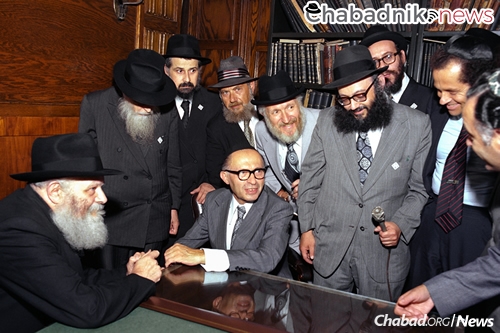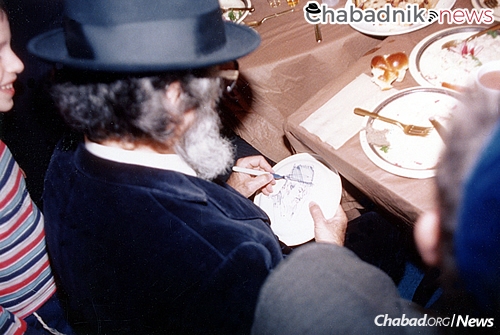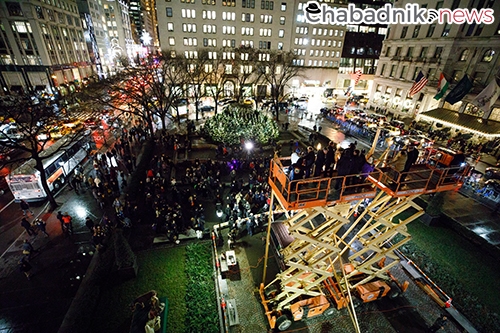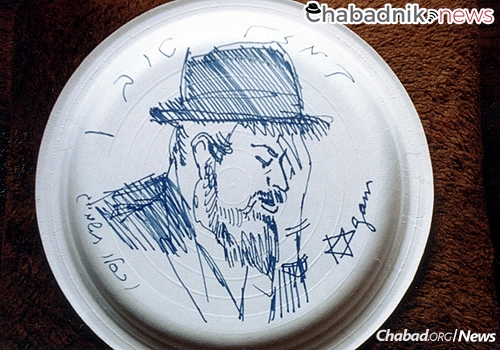How Atara Ciechanover spearheaded the design and creation of the world’s most visible menorah
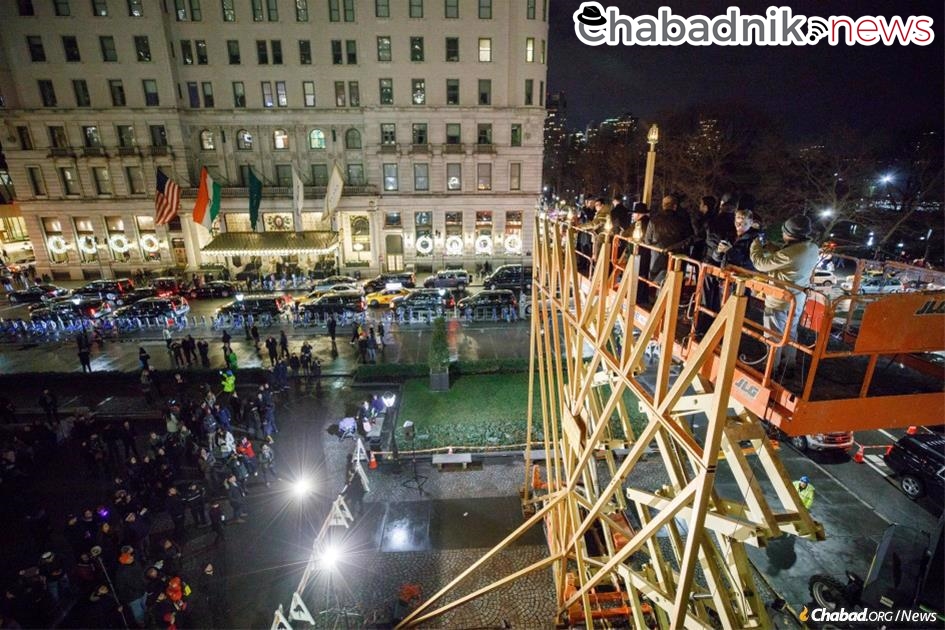
The gleaming two-ton Chabad-Lubavitch menorah on the corner of Manhattan’s storied crossroads at Fifth Avenue and 59th Street—one of the busiest and most affluent thoroughfares on the planet—has long been an inseparable part of life in New York. Throughout the eight days of Chanukah, the dancing flames atop the world’s largest menorah cast a luminous glow upon the city, beckoning to and inspiring millions. Whether on foot or riding in cars, taxis, limousines, bicycles, in the horse-drawn carriages emerging from Central Park or peering down from the comfort of the neighborhood’s luxurious homes and hotels, this public work of art has become an essential part of New York’s wintertime landscape.
The 32-feet-high sculpted bronze branches soar diagonally in front of the world-famous Plaza Hotel, supported by a 28-foot-wide casing—noteworthy for its arresting design, even alongside some of the world’s most prominent architecture, expensive office spaces, and exclusive residences and shops. The importance of a profoundly spiritual symbol proudly and elegantly spreading its Chanukah message from “the center of the world” has not been lost on the international media, which annually spreads this menorah’s holiday message of light and hope to hundreds of millions of people.
But that wasn’t always the case.
How did it get there? Who designed, built and erected it—and why? How did the Big Apple get such an iconic and utterly unmissable menorah?
It traces back to a woman with vision and determination, and a deep understanding of what the Rebbe—Rabbi Menachem M. Schneerson, of righteous memory—saw to be the place of Judaism in general and Chanukah in particular in the 20th and 21st centuries.
That woman was Atara Ciechanover.
The global campaign to publicize the miracle and message of Chanukah began in earnest in 1973, when the Rebbe spoke of the need to shine the light of the menorah wherever there was darkness and encouraged every Jew to spread the light and practices of Chanukah to their brethren worldwide. Chassidim got to work immediately. Little tin menorahs were designed, molded and churned out by the thousands; then the car-top menorah was invented and attached to vehicles everywhere. In 1974, a small public menorah was first lit in front of Philadelphia’s Independence Hall, followed the next year by a towering 25-footer in San Francisco, supported and promoted by legendary rock promoter Bill Graham. Soon, public menorahs sprouted up around the world.
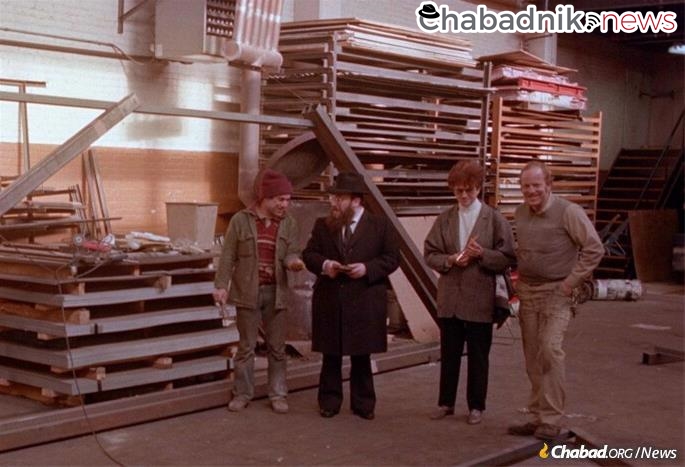
Towards the end of 1977, Lubavitch Youth Organization activists in New York were inspired to erect a large menorah in Manhattan. They found a company to weld together a collection of pipes for $5,000 and, sure enough, they had a menorah. Then, through a series of providential phone calls and more than a little chutzpah, Chabad received permission from New York City’s Parks Department to set up the menorah at Manhattan’s Grand Army Plaza, where it has stood ever since.
The menorah was tall. It held the candles aloft. Mayor Abe Beame came to light it that first time. Who cared about aesthetics?
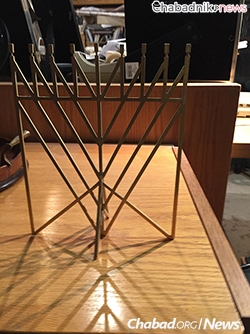
Atara Ciechanover did.
Ciechanover’s husband, Yosef, had held numerous Israeli government posts over the years, including director general of the Foreign Ministry, legal adviser to the Defense Ministry, head of Israel’s defense mission to the United States, and more. As a result of his work, the Ciechanovers spent years living in New York City—not far, in fact, from the site of the Fifth Avenue menorah.
During Chanukah of 1985, Atara Ciechanover passed by it and felt it was falling short of its goals. The rickety menorah’s tall stem—topped with the eight-branched candelabrum—was barely visible in profile, and seemed to fall short of the Rebbe’s desire to engage every single Jew and to spread Chanukah’s message of religious freedom beyond the Jewish community as well.
Ciechanover was quite familiar with the Rebbe’s vision. Within the capacity of his work for Israel, her husband served as a liaison between the Rebbe and the highest levels of Israel’s political and defense establishments, whose principals regularly sought the Rebbe’s counsel. The Ciechanovers’ relationship with the Rebbe stretched back to the 1960s, and over the years, the couple—together or individually—had spent tens of hours in conversation and consultation with him. As a designer and architect, she was also deeply aware of the Rebbe’s own concern and attention to aesthetics when it came to Jewish structures, symbols and buildings.
Moreover, the location—so central and attention-grabbing—was not being used to its fullest potential.
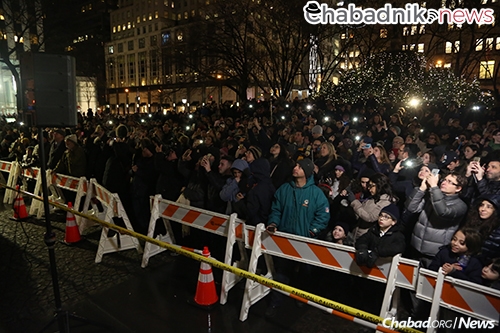
“She saw the menorah in front of the Plaza, and she didn’t like it,” recalls Yosef Ciechanover. “She felt it was not dignified enough to appropriately represent the Rebbe. She felt that such a central place like Manhattan—the center of the world—needs the most beautiful menorah of all.”
“Atara had extremely fine taste,” says a close family friend, Laya Klein. Klein’s husband, the late Rabbi Binyamin Klein, was a member of the Rebbe’s secretariat who served as a liaison for the Rebbe to Israeli government leaders and politicians, and became one of Yosef Ciechanover’s closest friends in the world. The friendship extended to the spouses, who spent much time together. “She was a very elegant woman. She had an eye for design, and she really, really cared.”
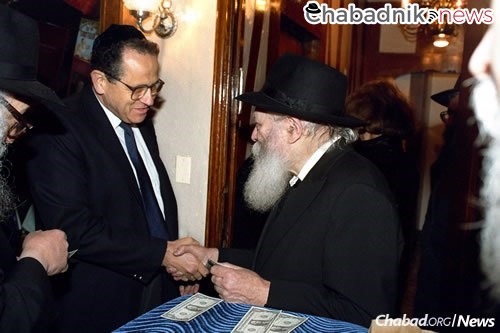
Beautiful and Dignified
Wasting no time, Ciechanover took her concerns, along with a suggestion for a new menorah design, directly to the Rebbe, while in private audience together with her husband.
“She told the Rebbe that she aimed to make a beautiful and dignified menorah,” says Yosef Ciechanover. “The Rebbe agreed with her concern and told her the new one should be built according to the design of the Rambam. He corrected her sketch to show what he meant by it.”
Menorahs had for a long time been built with curved branches, as famously depicted in relief on Rome’s Arch of Titus, which memorializes the Siege of Jerusalem. The Rebbe objected to the widespread use of this design to depict the Temple menorah—taken from a Roman triumphal arch meant to humiliate the Jewish people—that also contradicted a famous sketch of the Holy Temple’s menorah made by the Rambam (Maimonides), which clearly showed the menorah constructed with diagonal branches. The Rebbe posited that curved menorahs were used to illuminate other parts of the Temple and were differentiated from the main diagonal one. Though the Chanukah menorah has more branches than the Temple menorah, in order to celebrate the eight-day miracle, it is still meant to be evocative of the Temple menorah; therefore, the Rebbe preferred the design to be close to that of the original.
Following her meeting with the Rebbe, Atara Ciechanover met with the Lubavitch Youth Organization’s Rabbi Shmuel Butman, suggesting to him that she could ask her longtime personal friend, Israeli artist Yaacov Agam, to design a new menorah.
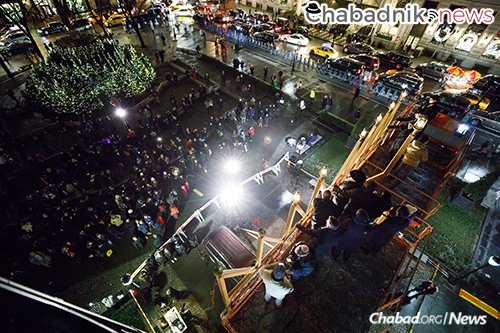
The Paris-based Agam was at the time already quite renowned, having just a few years earlier been the subject of a huge retrospective of his work at the Guggenheim Museum in New York. Today, the 88-year-old is Israel’s most widely-collected artist, living or dead. His colorful abstract work, often kinetic in nature, can be seen in sculptures in Buenos Aires, fountains in Israel, building facades in Miami and Tel Aviv, and in the permanent collections of institutions such as the Museum of Modern Art and the Guggenheim in New York City.
Agam took the commission, although not without some trepidation, saying that while he “was excited to fulfill a request coming from the Rebbe,” he did have some “internal hesitation” due to what he saw as “the complexity of the project.”
Over the next months, Atara Ciechanover threw herself into the menorah’s design and construction. Considering it a great merit, Agam donated his services free of charge, while the Lubavitch Youth Organization footed the construction bill. When Agam sent Atara Ciechanover one round of his design sketches for the menorah, her husband remembers her promptly taking them to the Rebbe for his approval.
“The Rebbe made corrections on Agam’s plans as well,” recalls Yosef Ciechanover.
Finally, Agam arrived in New York with a miniature model of his design. Butman gave it to Rabbi Klein, so that he could then show it to the Rebbe for his approval. Three days the model sat on the Rebbe’s desk before an emphatic stamp of approval was given. Butman remembers Klein telling him that he had mentioned to the Rebbe that it was shaped differently than the Rambam’s classic menorah design.
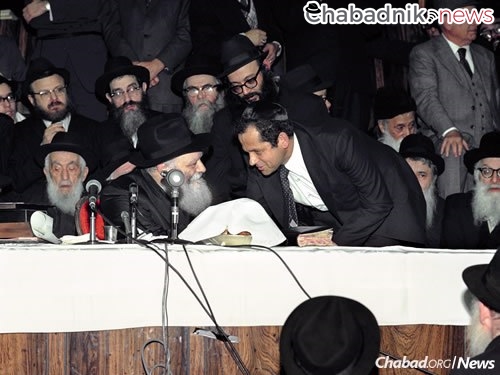
The Rebbe responded that the primary emphasis of a menorah according to the Rambam is its diagonal branches. Within those parameters, however, an artist such as Yaacov Agam must be given the space to express himself.
Atara Ciechanover’s involvement with the menorah did not remain only on paper. Recently uncovered photos in the archives of Jewish Educational Media (JEM) show her touring the factory where the menorah was being constructed with Butman. “It was totally her project,” remembers Butman.
“The planning and production took a long time, and she was involved throughout,” says Yosef Ciechanover, adding that Agam personally oversaw construction of the menorah as well. “It was Agam’s design, and he had to approve every step of the process.”

‘Modern and Ancient’
On Friday, Dec. 26, 1986, Agam’s menorah was lit for the first time. The menorah has been lit every year since, this year marking its 30th in use.
“I didn’t only want to create something beautiful; the Romans could also create something beautiful. I wanted to create something that was beautiful and Jewish,” Agam shared with the Rebbe. “My goal was to make something beautiful, Jewish and true to its roots. That it should be modern while conveying the ancient.”
Millions of people have since seen and been inspired by Agam’s menorah—its “beautiful and Jewish” nature taking a place of prominence in a focal point of New York City. It could not have happened without the vision and dedication of Atara Ciechanover.
“She was very happy with how the menorah came out,” says her husband. “It’s beautiful, and that was her aim. She saw it as an opportunity to make a point by having the most beautiful Chabad menorah in the center of the world. It makes me happy every time I see it.”
Atara Ciechanover passed away in 2012, but her labor of love stands as a beacon of the timeless message of religious freedom—to New York City and the world, for generations to come.
